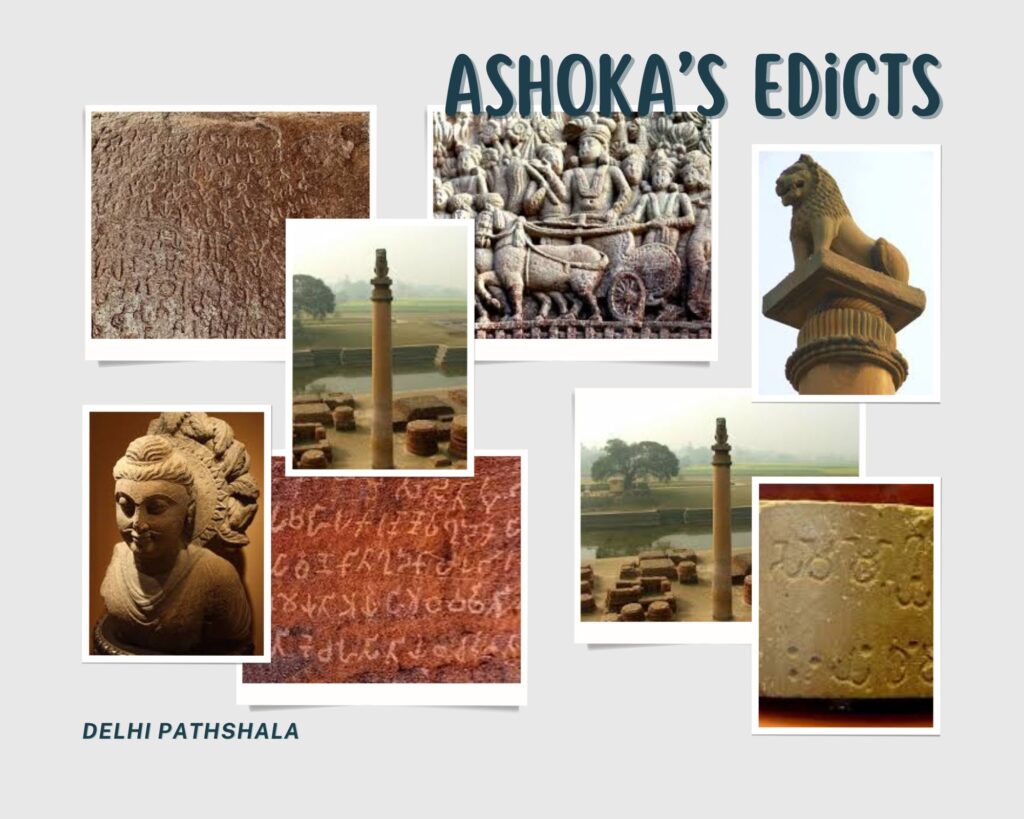History (GE–1)
Delhi Through Ages notes
unit–1: Ancient Delhi and Adjoining Sites, Part–2
Ashoka’s Edicts
In this post, notes of Unit (Ancient Delhi and Adjoining Sites – Ashoka’s Edicts) from GE – 1: (Delhi Through Ages) are given which is helpful for the students doing graduation this year.
Ashoka’s Edicts
Locations and significance of the Ashoka’s Edicts.

The Ashoka’s Edicts are inscriptions attributed to the Mauryan Emperor Ashoka, who ruled much of the Indian subcontinent in the 3rd century BCE. These inscriptions are found in various locations across the Indian subcontinent and beyond, conveying Ashoka’s teachings, policies, and messages of moral conduct and social harmony. Here are some notable locations and the significance of the Ashoka’s Edicts:
Dhauli, Odisha:
- The Dhauli Edicts are located near Bhubaneswar in Odisha, India.
- These edicts are inscribed on a rock face and a pillar, commemorating Ashoka’s conquest of the Kalinga region and his subsequent conversion to Buddhism.
- The Dhauli Edicts emphasize Ashoka’s commitment to non-violence, religious tolerance, and social welfare.
Sarnath, Uttar Pradesh:
- The Sarnath Edicts are found in Sarnath, near Varanasi, Uttar Pradesh, India.
- These edicts are associated with Ashoka’s visit to Sarnath, where he delivered his famous sermon after embracing Buddhism.
- The Sarnath Edicts emphasize moral principles, including compassion, respect for parents, and reverence for all religious sects.
Pillars and Rock Edicts across India:
- Ashoka erected numerous pillars and rock edicts across his empire, spreading his message of Dhamma (Buddhist principles) to his subjects.
- These edicts are found in regions such as Bihar, Uttar Pradesh, Madhya Pradesh, Gujarat, and Andhra Pradesh.
- The edicts on pillars and rocks often detail Ashoka’s efforts to promote ethical governance, religious tolerance, welfare measures for humans and animals, and environmental conservation.
Other Locations:
- Ashoka’s edicts have been discovered in places beyond the Indian subcontinent, including Afghanistan, Pakistan, and Nepal, reflecting the extent of the Mauryan Empire’s influence.
- For example, the Kandahar Edict in Afghanistan and the Mansehra Rock Edicts in Pakistan attest to Ashoka’s rule in these regions and his propagation of Buddhist ideals.
The significance of the Ashoka’s Edicts lies in their historical, cultural, and philosophical value. They provide insights into Ashoka’s reign, his governance philosophy, and the spread of Buddhism during the Mauryan period. Additionally, these edicts serve as important archaeological and epigraphical sources for understanding ancient Indian history and the evolution of moral and ethical principles in South Asia.
The content and messages conveyed through the edicts.
The Ashoka’s Edicts convey a range of messages and teachings that reflect Emperor Ashoka’s commitment to moral conduct, social welfare, religious tolerance, and ethical governance. While the specific content may vary across different edicts, they generally emphasize the following themes:
Promotion of Dhamma (Dharma):
- Ashoka’s foremost message in many of the edicts is the promotion of Dhamma, which encompasses moral and ethical principles.
- He encourages his subjects to follow Dhamma, which includes virtues such as honesty, compassion, non-violence, kindness, and respect for all living beings.
Religious Tolerance:
- Ashoka emphasizes religious tolerance and encourages respect for all religious sects.
- He states that he does not favor any particular religion but rather promotes the welfare of all people, regardless of their beliefs.
Social Welfare:
- The edicts highlight Ashoka’s commitment to the welfare of his subjects, including measures to alleviate poverty, provide healthcare, and support the disadvantaged.
- He orders the construction of hospitals, the planting of medicinal herbs, and the distribution of medical treatments to both humans and animals.
Administrative Reforms:
- Ashoka’s edicts often detail administrative reforms aimed at ensuring justice, fairness, and efficiency in governance.
- He instructs officials to be accessible to the public, to treat people with impartiality, and to avoid corruption and oppression.
Environmental Conservation:
- Some edicts advocate for environmental conservation and the protection of natural resources.
- Ashoka expresses concern for forests, wildlife, and water bodies, urging his subjects to avoid harming them and to conserve these resources for future generations.
Pillar Edicts vs. Rock Edicts:
- The messages conveyed in the pillar edicts and rock edicts are generally consistent, but they may vary in emphasis and detail.
- Pillar edicts are shorter and more concise, focusing on core principles of Dhamma, while rock edicts tend to provide more detailed instructions and examples of Ashoka’s policies and initiatives.
Overall, the Ashoka’s Edicts serve as a testament to Ashoka’s vision of a just and compassionate society and his efforts to govern according to ethical principles. They provide valuable insights into the social, political, and ethical values of ancient India and continue to inspire discussions on governance, ethics, and religious pluralism.
The edicts’ role in understanding Mauryan governance and Buddhism.
The Ashoka’s Edicts play a crucial role in understanding both Mauryan governance and the spread of Buddhism during the reign of Emperor Ashoka. Here’s how:
Mauryan Governance:
- The edicts provide valuable insights into the administrative policies and governance structure of the Mauryan Empire.
- They reveal Ashoka’s emphasis on ethical governance, justice, and social welfare, highlighting his efforts to ensure the well-being of his subjects.
- By detailing Ashoka’s directives to his officials and subjects, the edicts shed light on the administrative machinery of the Mauryan state, including aspects such as law enforcement, taxation, and public works.
- The edicts also demonstrate Ashoka’s use of propaganda and communication strategies to disseminate his policies and principles throughout the empire, showcasing his understanding of governance and communication.
Buddhism:
- The Ashoka’s Edicts provide significant evidence of Ashoka’s embrace of Buddhism and his role as a patron of the religion.
- They reflect Ashoka’s commitment to spreading Buddhist principles and teachings throughout his empire, as evidenced by his promotion of Dhamma (Buddhist ethics) and his construction of Buddhist monuments and institutions.
- The edicts reveal Ashoka’s personal conversion to Buddhism following the Kalinga War, as well as his efforts to encourage his subjects to adopt Buddhist practices and values.
- By advocating religious tolerance and respect for all faiths, the edicts illustrate Ashoka’s vision of a pluralistic society and his belief in the universality of moral and ethical principles.
- Through his patronage of Buddhism and the propagation of Buddhist ideals, Ashoka played a significant role in the expansion and institutionalization of Buddhism in ancient India and beyond.
Overall, the Ashoka’s Edicts serve as invaluable historical and textual sources for understanding both the administrative policies of the Mauryan Empire and the spread of Buddhism during Ashoka’s reign. They provide a window into the socio-political and religious dynamics of ancient India and offer insights into Ashoka’s governance philosophy and his contributions to the development of Buddhism as a major world religion.


